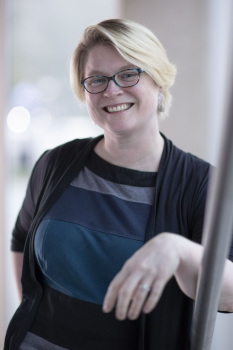CSE's Only North Star Course: Transitioning Ideas to Reality

When CWRU introduced North Star Courses and Experiences to focus on Cleveland-based and on-campus activities, Professor Jennifer Carter realized her course, EMSE 110 - Transitioning Ideas to Reality I - Materials in Service of Industry and Society, was “essentially already a North Star course.”
The only North Star course in the School of Engineering, EMSE 110 is designed to showcase materials and manufacturing jobs in the greater Cleveland area. In non-coronavirus times, students in the class took weekly field trips to facilities throughout the Cleveland area, where they took a tour of the facility and employees talked about their work. This semester, Carter will be bringing in a speaker each week via zoom to talk to the students and show people working in their place of work. Most of the speakers are based in Cleveland. The goals of the course are to help students find places where they can get jobs, internships and research opportunities.
“Many students are wondering, ‘How do I choose a career? How do I get there?’” said Carter. The course was originally a senior course, but became a freshman course in 2015 because “seniors often already have a career picked out.”
The course meets once a week and is divided into three modules. The first module, “Value of the National Labs,” will bring in speakers from NASA Glenn Research Center (the country’s only Cleveland-based national laboratory), Los Alamos National Laboratory and Wright Patterson Air Force Base.
The second module, “Materials Across The Design Lifecycle,” will focus on design life cycles, recycling, design for application, optoelectronic devices, layered commercials and limits to the use of materials.
The third module, “Primary Processing,” is Carter’s favorite and highlights how heat and pressure are used to manufacture polymers, ceramics and metals.
The semester will also include two speakers talking to the students about how even if your career doesn’t go as expected, there is still value.
At the end of each module, students will reflect on the similarities and differences of the practices at each place they “visited.” “How do they use the same materials science? How do they use the same heat treatments? How do they recycle? Everything gets recycled,” said Carter, pointing out that there is no real waste in materials science.
All invited speakers have some connection to the Department of Materials Science and Engineering. Some are alumni of the department, while others are research collaborators.
Carter has co-taught EMSE 110 with Professor James McGuffin-Cawley in the past and is teaching it on her own for the first time this semester.
This semester’s speakers, affiliations and the focuses of their talks are:
Value of the National Labs
- NASA
- Othmane Benafan: Shape memory alloys for lightweight space and aerospace applications
- Stephanie Vivod: flexible aerogels for thermal protection and lightweight applications
- Doug Kiser: ceramic matrix composites for high-temperature applications (rocket and jet engines)
- Los Alamos National Lab: Saryu Fensin - Molecular dynamic simulations of materials in extreme environments
- Wright Patterson Airforce Base: Eric Payton - Alloy development and manufacturing for aero applications
Materials across the Design Lifecycle
- (tentative) ArcelorMittal: Steel for automotive
- Think[box]: Ian Charnas- CWRU engineering design innovation for COVID-19 solutions
- First Solar: Mike Koralewski- how layered material architectures enable industries
Primary Processing
- Saint Gobain Crystals: Peter Menge - how to manufacture single crystals for sensors
- Fort Wayne Metals: Small-scale wires enable biomedical devices
- PolyOne: Polymers for consumer applications
A Career in Perspective: It never goes as expected, but is still fun.
- Arun Varshneya: Glass technologies to enable better humanity (EpiPens to cell phones)
- Robert Fedor: Appollo missions, electric vehicles, and cleaning up some of the nation's largest Superfund sites

